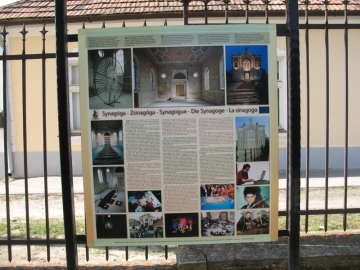So -- here's my latest Ruthless Cosmopolitan column about the experience.....
Ruthless Cosmopolitan: Michael Jackson and the Jewish noseBy Ruth Ellen Gruber - June 29, 2009
VIENNA (JTA) -- Amid all the noisy outpouring over Michael Jackson's sudden death, the last place I expected to find him was in a Jewish museum. But there he was, his pale, mask-like, surgically engineered image featured as part of an exhibition at the Jewish Museum in the Austrian capital.
Called "Typical! -- Cliches of Jews and Others," the exhibition deals with the use (and abuse) of ethnic stereotypes in popular culture. The exhibition, which runs until October, has been shown at the Jewish Museum in Berlin and the Spertus Museum in Chicago.
It was assembled long before Jackson died June 25 in Los Angeles.
In a life-size photograph from 2002, he is shown with lank black hair framing a long, square stubbly chin, pinched red mouth, huge made-up eyes and a tiny nose with distorted pointy tip.
The photo is used to illustrate how, for better or worse, the King of Pop attempted to destroy stereotypes and, literally, to cut himself away from the confines of physical definition.
Jackson's "surgical transformations mirrored back to the culture the blurring of boundaries demarcating adulthood, sex and even race," Guy Trebay wrote in The New York Times after Jackson's death.
The "Typical!" exhibition deals with stereotypes commonly used to categorize African Americans, Muslims, women, Native Americans and others.
But given that it is mounted at a Jewish museum, much of its focus is on stereotypes about Jews. The exhibition poster employs a few sketched strokes to conjure up some: corkscrew curls, a hat and a huge hooked nose.
Indeed, the multitude of variations on the (alleged) size and shape of the Jewish nose form a major theme.
"The paradigm for the 'typically Jewish' nose originated in the craniological studies of Johann Friedrich Blumenbach," an information panel informs. A German natural scientist who died in 1840, Blumenbach "claimed to have evidence that Jews had an especially prominent nasal bone."
Exhibit installations examine the misuse of this and other paradigms in "scientific" teaching, as well as the ways in which they became part of the vernacular shorthand that shapes the way we see others and ourselves.
A section called "the schnoz," for example, shows a collection of 19th century walking sticks whose handles are formed by exaggerated noses. The contemporary artist Dennis Kardon's installation "Jewish Noses” features dozens of larger-than-life-sized casts made from the noses of actual Jews to demonstrate the silliness of such nasal cliches. Also, a modern painting ironically comments on the love and success that are supposed to result if one has a nose job.
"I am often asked whether or not Jews have a 'Semitic' nose," reads an exhibition quote by the historian Sander Gilman, who has written extensively about Jewish stereotypes. "After 54 years of experience, I can only answer that every Jew I have ever met has a nose."
The inclusion of Jackson's picture in the mix highlighted the transformations his own nose infamously went through.
It also reminded me of a book I read some years ago, a vicious anti-Semitic satire called "The Operated Jew," that was written in 1893 by a German doctor named Oskar Panizza.
An attack on efforts by Jews to assimilate into mainstream society, the book is a creepy and extremely disturbing tale about how a Jew named Itzig Faitel Stern tries to rid himself physically of the stereotypical signs of his Jewishness and become a "modern" European.
Foreshadowing Jackson's experiences under the knife, Stern submits to radical procedures, including the straightening and bleaching of his hair, "Extreme Makeover"-style cosmetic surgery and a series of horrendous operations to straighten his bones. He even gets a full transfusion of "Christian blood."
"It is impossible for me to give the reader an account of all the garnishings, changes, injections and quackeries to which Itzig Faitel Stern submitted himself," the narrator states. "He experienced the most excruciating pain and showed great heroism so he could become the equivalent of an occidental human being."
In the end, it doesn't help. At his wedding to a Christian woman, all falls apart and Stern "reverts" to the ugliest anti-Semitic cliche of the Jew.
Panizza, an early exponent of Nazi-style racial anti-Semitism, set out to "prove" that Jews could never become part of the mainstream modern world, even if they physically attempted to change their skins.
It's not exactly clear what world Jackson was trying to become part of -- or leave -- with his surgeries and other transformations.
Artistically he was the ultimate crossover, winning fans of all colors, ages, religions, nationalities and sexual orientations all around the world. Over the years, though, he alienated some African Americans by his physical manipulation of identity and apparent ambivalence about his own blackness.
Death, though, appears to have brought Jackson back to his roots -- or in any case to a warm embrace by the African-American community.
“We want to celebrate this black man," the actor and singer Jamie Foxx said to cheers at the Black Entertainment Television Music Awards Sunday. "He belongs to us, and we shared him with everybody else.”
Foxx added, "It didn't matter what he looked like, it was all about what he sounded like. It didn't matter what his nose looked like -- I loved the old nose and the new nose."






